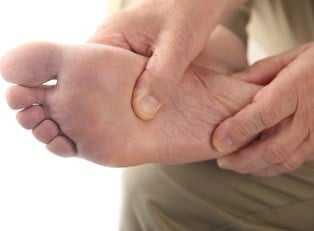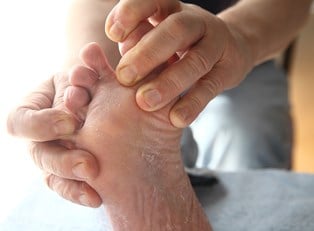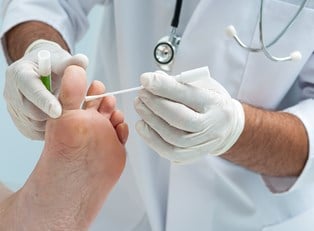Athlete’s foot is a fungal infection that affects the soles of your feet and the skin between your toes. Since burning and itching are usually associated with the infection, it can be very uncomfortable. Fortunately, there are nine simple actions you can take to avoid athlete’s foot.
- Protect your feet.
Always wear protective footwear such as shower shoes, flip-flops, or sandals when walking around public areas such as pools, gyms, showers, locker rooms, and hotel rooms. The fungus that causes athlete’s foot can live on the floor, and it can easily be picked up by bare feet. - Keep your feet dry.
Keep your feet dry as often and as long as possible. Since the fungus thrives in moist, warm environments (like those created by hot, sweaty shoes and socks), avoiding this as much as possible is key. Unless you are working out or doing something active that requires tennis shoes, try to wear sandals when it’s hot outside. If you have to wear tennis shoes on a regular basis, let your feet air out as much as you can whenever you are resting or at home. - Keep your feet dry.
Wash your feet every day with soap and then completely dry them afterwards, taking extra care to dry between your toes. This will kill any fungus that might have started to grow on your feet and prevent more from moving in. Wash your socks twice in extra-hot water to kill fungal spores before wearing again. - Choose shoes carefully.
If you wear tennis shoes often, make sure to choose shoes with fabric that is light and well-ventilated, since these will be able to breathe more easily. Avoid shoes that are tight-fitting and made from synthetic materials such as vinyl, plastic, and rubber, since these are more likely to cause sweating. Also, if possible, try not to wear the same tennis shoes two days in a row. Switching back and forth between more than one pair gives your shoes time to completely dry out before you wear them again. - Choose socks carefully.
Buy socks that are made of natural fabrics such as cotton and wool since these kinds of fabrics will dry faster. Socks made of materials such as acrylic also work since they wick the moisture away from your skin. Experiment with both kinds to see which ones work best to keep your feet as dry and comfortable as possible. Also, make sure you change your socks every day or more often if your socks get wet during the day. Don’t put on socks before your feet are completely dry. - Be careful when you share.
Since athlete’s foot is so highly contagious, don’t share towels, linens, or shoes with anyone who might be infected. If you live with someone who has athlete’s foot, wash towels and bedding frequently to prevent the infection from spreading. - Take preventive measures.
If you are prone to getting athlete’s foot, you can apply an antifungal medicated powder to your feet every day before putting on your tennis shoes to stop the infection before it can ever start. There are other, non-medicated options as well. For example, sprinkling baking soda directly into the shoes has been proven to help with prevention as well. Also, cornstarch is excellent at absorbing moisture, so rubbing it directly on your feet can help keep them dry. - Stock your frigerator.
Garlic has been shown to have anti-fungal properties, so eating foods that are seasoned with garlic or even rubbing it directly on the feet can be helpful. Yogurt is also a good food that helps fight fungal infections. Eating yogurt that contains active bacteria and live cultures helps keep your body in balance. - Boost your immune system.
Low immunity makes you more susceptible to any kind of infection, including athlete’s foot. Therefore, eating immunity-boosting foods can help your body be better prepared for fighting off fungal infections. Some examples include broccoli, red meats, and scallions.



